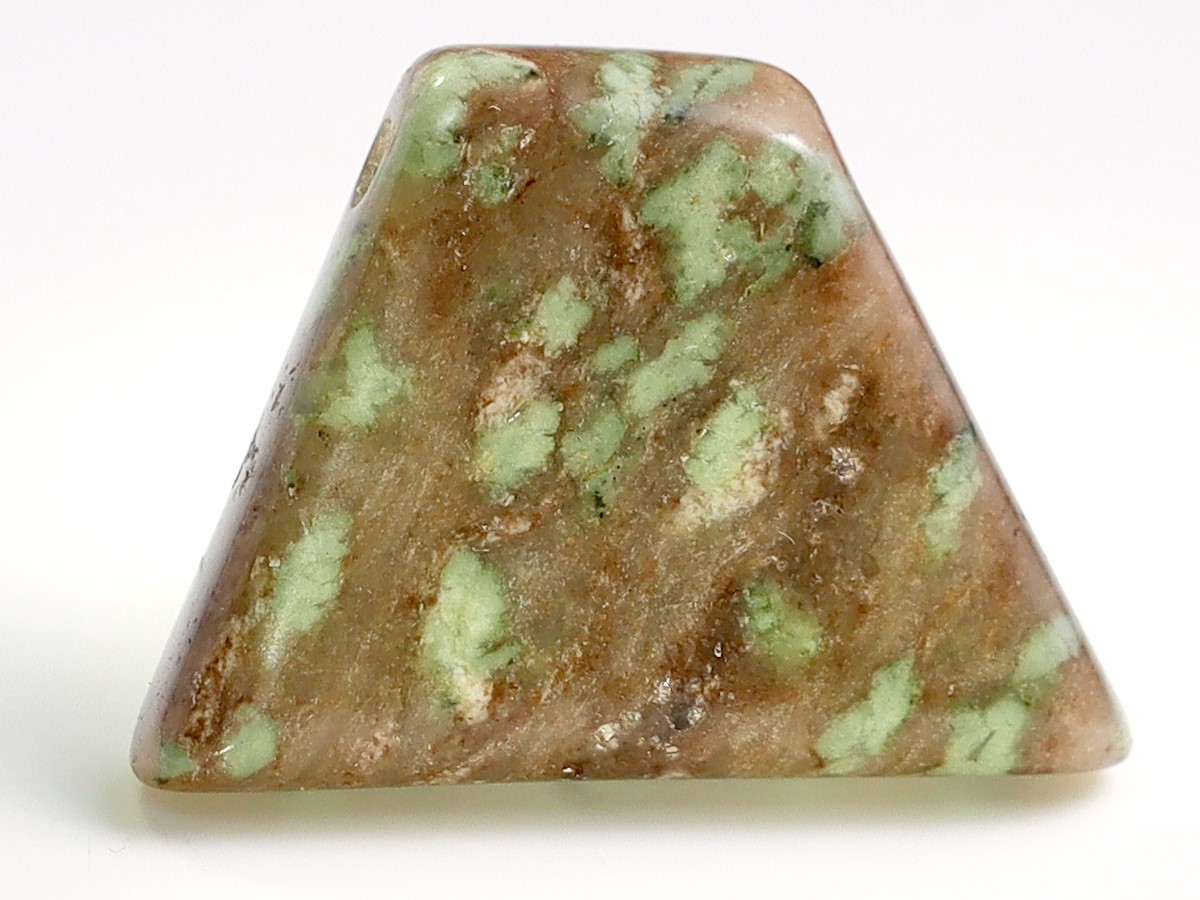_____________________
There are not only different names and spellings for this rock from Australia in the literature and in the trade, but also different places where it was found. It is questionable whether all these informations mean exactly the same rock. The rock presented to the EPI laboratory with the trade name "Nundorit" consists of light green, cloudy areas embedded in a colorless to brown matrix (Fig. 1). Small particles of opaque ore minerals are unevenly distributed throughout the rock.
Nunderite in literature and Internet
1. in the book "Gems, their sources , descriptions and identification" by R. Webster, which is described by some readers as the "bible of gemmologists", a rock is described (unfortunately without a photo) with the description "Nunderite from Nudel in New South Wales, Australia": "This brown stone with green splashes is a combination of Jadeite and Plagioclase Feldspar". Since jadeite from New South Wales is not described anywhere else, this reference should be taken with a grain of salt.
2. another rock composition given at Mindat.org "Aegirine-Orthoclase Syenite from Nundoora Station near Broken Hill called Nundoorite" possibly applies to a site that was developed for lapidary purposes in the 1960s. The pit was not particularly large. It has been closed for many years and can no longer be entered. Therefore, the material offered today cannot come from this mine.
3 The Geological Survey of New South Wales describes the currently available rock as follows: "As far as we know, this rock contains the minerals albite, aegerine, nepheline and natrolite, as well as some other minerals. The natrolite probably crystallized long after the other minerals. It is an altered mafic alkaline igneous rock. This particular rock has been heavily altered, possibly by superheated seawater on the sea floor, shortly after it was deposited - which is interpreted due to the unusual sodium-bearing minerals in the rock. There is only one outcrop of this type of rock in the world. " [Source: Mindat.org].
4. various websites on the Internet give further possible rock compositions. Here is a small selection: "Andalusite with areas of green epidote", "Epidote in matrix with andalusite", "reddish orthoclase feldspar with green epidote".
Rock analysis

Fig. 2: Magnification of nunderite rock.
Foto: J. Lorenz
Collecting all these different informations it became clear that our own gemological/mineralogical investigations would be necessary in order to characterize this gemrock. Advanced analytical techniques such as Raman laser analysis and X-ray diffraction spectrometry were used for this purpose. Using these techniques, mainly potassium feldspar (orthoclase) with natrolite were found - and a pyroxene mineral that could not be precisely determined. The spectrum found was best suited to the sodium (Na-) pyroxene aegirine. The presence of jadeite, epidote or andalusite could not be confirmed.
A thin section of the rock revealed that the brownish to colorless groundmass consists of potassium feldspar, which is intimately intergrown with natrolite. The greenish areas contain a partly altered pyroxene mineral (aegirine).
Assumed Genesis
Nunderite probably formed from a quartz-poor (mafic) igneous rock, which consisted of a lot of feldspar and some larger pyroxene crystals (porphyroblasts). This source rock was later transformed (altered) with the addition of sodium. The existing feldspar was largely decomposed and is only present in traces (relict). At the same time, new zeolite minerals have formed, especially sodium-rich natrolite. The original high-pressure pyroxenes have been preserved as "dissolved" relicts and are visible as green patches in the rock.
Conclusion
During the 1960s various deposits of rocks that resembled today's nunderite were existing probably. One of these, whose location was given as "Nundel in New South Wales, Australia", was called "Nunderite". An occurrence of a similar rock was found at Nundoora Station near the village of Broken Hill, also in New South Wales, Australia. This rock was called "Nundoorite" or "Nundorite". Both deposits have been exhausted for decades.
The mineralogical composition of the rock from Australia currently marketed under the trade name "nunderite" corresponds to a metamorphically transformed volcanite. An intimate intergrowth of feldspar with natrolite forms the colorless to brownish groundmass. Partially decomposed clinopyroxene is responsible for the greenish clouds in the rock.
Author: B. Bruder, © EPI - Institut für Edelsteinprüfung (www.epigem.de)




